Roland Hp 1500 Digital Keyboard Electric Piano Review
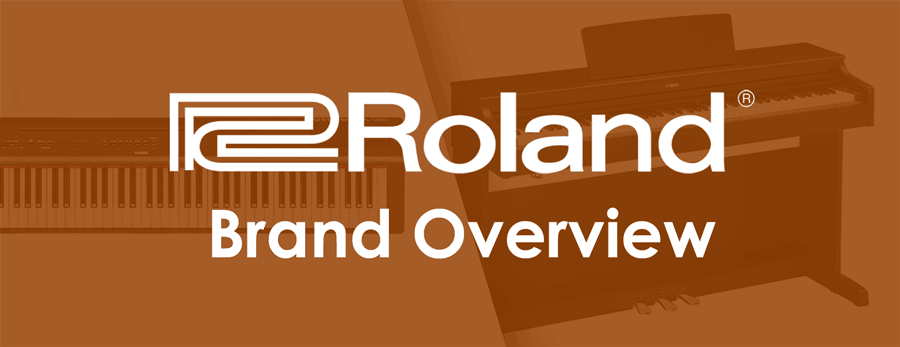
Roland is easily one of the most recognizable names in the music business organisation.
Their name alone is enough to inspire confidence in the audio and build quality of a keyboard, which is no pocket-size feat considering their expansive product range.
Since Roland has products geared towards users at every price signal, yous might experience a bit overwhelmed by the amount of options you take.
What'south the deviation between a synthesizer and a workstation? What's the difference between the many fundamental deportment? What'south SuperNATURAL?
Have no fearfulness. This article volition requite you an overview of the all-time Roland digital pianos while besides giving some insight into the workings of Roland's many keyboard-based instruments, including: digital pianos, arranger keyboards, stage keyboards, synthesizers, and workstations.
Note that nosotros'll be skipping over Roland'southward products in the pro-audio category and their guitar/bass products under their BOSS brand.
While these products are also well received throughout the industry, this commodity volition focus on keyboards and digital pianos.
About Roland
- Founded: 1972
- Headquarters: Hamamatsu, Shizuoka, Nippon
- Number of Employees: iii,060
- Products: Digital Pianos, Synthesizers, Electronic Drums, Organs, Pro Recording & Production Equipment, Guitar/Bass Equipment
Roland, founded in 1972, might seem immature compared to other industry giants like Yamaha, but they've definitely had their fair share of successes, which have catapulted them to stardom.
Roland's timeless nature stems from their huge legion of iconic instruments, nearly of which are easily recognizable in hit songs through the years, fifty-fifty today.

Roland Jupiter 8
While Yamaha's DX7 controlled the realm of digital synthesis in pop music, Roland'due south Jupiter 8 and Juno-60 were become-to synthesizers for lush pads and leads.
Michael Jackson's Thriller was a masterpiece, and the producer, Quincy Jones, used the Jupiter viii for the rolling bassline and synth brass sounds.
While the Linn Drum has go the de facto standard for drum machines with its acoustic-like drum sounds, Roland's TR-808 and TR-909 remain relevant to this day.
Iconic moments include Marvin Gaye (in 1982'south Sexual Healing), Kayne Due west (in his 2008's 808s and Heartbreak anthology), and Taylor Swift (using Max Martin'south original TR-808 in 2014'south chart topper Blank Space).

Roland TR-808
Finally, Roland's been at the forefront of digital piano technology since the early 80s.
Start with their RD-series, they have attempted to charge into the digital piano market, relying on innovation and feel to gain a foothold. Afterward nearly 30 years of dominance, I'd say they've succeeded.
Many features nosotros take for granted today, such as pressure sensitivity, MIDI, and modeling, were pioneered by Roland in their early years.
The secret to Roland's success is their focus on innovation, polish, and playability.
Roland's CEO, Jun-ichi Miki, states, "Our mission at Roland is to bring the thrill and excitement of creative experiences to imaginative people all over the world." It's difficult to argue with their results.
The 3D video tour below (drag your mouse to become a 360° view) will walk you through all the ranges of musical instruments that Roland take been creating and improving over the years.
As someone who loves following the world of music applied science, I can't help but appreciate what Roland has done.
With SuperNATURAL, Roland didn't but make a modeling engine to tick a checkbox.
Information technology'south one of the rare piano modeling technologies that trusts you lot as the user with the cockpit controls. With their JD-11 synthesizer, Roland brought polyphonic analog synthesis dorsum to the mainstream.
With their FA-series workstation keyboards, Roland made workstations less intimidating to the histrion who merely wanted good sounds without the scariness of having to pattern them.
In 2021, Roland partnered with Pianote, a popular online piano platform, which uses technology and video lessons to teach you how to play this marvelous instrument. So if y'all live in the U.s. or Canada and ain a Roland piano, you lot tin can get 3 months of Pianote lessons for free!
I could get on and on about how Roland shaped the industry, but that's not why we're here. Instead, permit'south jump to the important details of Roland's technologies and products.
Roland Product Line-up
Roland makes a huge variety of products, then covering them individually would take way too long.
We've separated the different keyboards into specific categories based on their feature prepare and intended apply. We'll then give our quick takes on the corresponding series and products, providing links to detailed reviews whenever bachelor. That said, let's jump in.
Portable Keyboards
Portable keyboards are aimed at pianoforte-playing novices. These keyboards, every bit the name implies, characteristic cardinal-beds with less than 88-keys and utilize the basic synth-action keys without many bells and whistles.
Don't expect too much in terms of build quality either, as you'll be dealing with pure lightweight plastic (which could be a blessing in disguise if yous're constantly on the motion).
While these keyboards are a little lacking in terms of design, they brand upwardly for it in features.
These keyboards usually come with a huge amount of sounds, though they are passable at best. As well, it's difficult to fence with the low price tag, frequently going for around $100-$300.
If you know someone who's unsure if music will be a long-term passion, they're probably in the marketplace for a portable keyboard.
Become:Series
Musical instrument Type: Portable Keyboard
User Level: Beginner
Price Range: $300-$400
Models:
- Roland GO:PIANO88
- Roland GO:PIANO
- Roland Get:KEYS
The Go:Series is a relatively new addition to Roland's production lineup, focusing on packing playability and as many features as possible into a compact package.
The GO:Piano is bones in terms of bells and whistles, but it includes an impressive sound engine for the cost.
It is arguably the best low-cost beginner keyboard out there if you're looking for piano sounds. An 88-key variant is as well available for a slight bit more toll.
The Become:Keys, on the other hand, feels like a unique musical instrument.
The Get:Keys is all about performances and allows you to build up a song from scratch using the loop functionality, adding elements in one at a time to create lush, studio-ready arrangements.
It also does this in a beginner-friendly manner, so even not-musicians tin enjoy it.
This is very different to how Yamaha and Casio do their portable arranger keyboards, and information technology'due south welcome to see Roland'south innovative spirit at this price point.
E-X Series
Instrument Blazon: Portable Arranger Keyboard
User Level: Beginner
Price Range: $250-$300
Models:
- Roland East-X20
- Roland Eastward-X30
The E-X Series keyboards are arranger models, but this market place has always been dominated by Yamaha (with their affordable PSR range) and Casio (with their CTK-serial).
Roland'due south E-X20 didn't exactly turn heads when it was released, doing lilliputian to separate itself from the pack.
However, the recent release of the Eastward-X30 might just be the break-out hit Roland was looking for.
While nosotros've even so to get our easily on the newcomer, many publications are giving it glowing reviews, citing an improved audio engine as a massive plus over the competition.
Standard arranger features bated, the deal maker hither is the piano sounds, which sound quite realistic considering the price point.
Portable Digital Pianos
If you're serious about learning to play the piano, you Need to have some semblance of realism. This means yous're looking for good keys and sound quality.
If you're upkeep-conscious, this means you'll be looking into portable digital pianos. These are sometimes referred to as slab digital pianos due to the style they expect.
They don't feature the furniture-way cabinets you'd find on total-fledged digital pianos, simply they do include fully weighted hammer action keys, an upgrade from keyboards and more preferable for serious do.
FP-Series
Instrument type: Portable Digital Piano
User Level: Beginner to Advanced
Cost Range: $500-$2,000
Models:
- Roland FP-10
- Roland FP-30X
- Roland FP-60X
- Roland FP-90X
The FP-serial is one of Roland's acknowledged product lines, and it's non hard to see why.
All FP-serial digital pianos (except the flagship FP-90X) feature the PHA-4 Standard central action and the SuperNATURAL sound engine, essentially making them the complete parcel when it comes to piano playing.
It is important to notation that you're getting a no-frills experience here, as well as a limited option of sounds, though they are of a significantly higher quality than those on the GO:series in a higher place.
Fun fact! The FP-90 (predecessor of the FP-90X) received the 2017 Red Dot Design accolade for an excellent control scheme, which is futuristic and intuitive.
This beat out 5,500 entries in its category, which was no pocket-sized feat. The same design was recreated with the FP-60X, with slight differences to achieve a lower price indicate.
Console Digital Pianos
While portable digital pianos focus on delivering a compact yet complete experience, console digital pianos feature large furniture-fashion cabinets that look similar to real audio-visual uprights and grands.
The larger cabinets on loftier-end models aren't simply for show either, for they incorporate multi-speaker sound systems that deliver a more accurate soundscape during play.
Naturally, this comes at the cost of portability, but I'd say the trade-off is more acceptable since yous're getting better sound quality, fifty-fifty on the cheaper models.
If you lot know for certain that you'll be practicing in the comfort of your ain home, a console digital piano might be right for y'all.
RP- and F-Serial
Musical instrument Blazon: Console/Home Digital Piano
User Level: Beginner to Intermediate
Price Range: $1,000-$1,600
Models:
- Roland RP102
- Roland RP701
- Roland F701
The RP- and F-Series console digital pianos are very similar, differing only in design. While the RP-Series features a traditional chiffonier, the F-serial uses a modernistic slim pattern popularized by Casio.
Feature-wise, these digital pianos are like to the FP-series discussed earlier, featuring the PHA-four Standard key activity and the SuperNATURAL Piano Sound engine.
A personal upside I like about these over their FP-counterparts is the sliding cover, a godsend if you play in a dusty environment.
Obviously, you also get a iii-pedal setup with these digital pianos. With the FP-series, that would be a separate purchase.
HP- and DP-Serial
Musical instrument Type: Console/Abode Digital Piano
User Level: Intermediate to Advanced
Price Range: $i,800-$ii,500
Models:
- Roland HP-601
- Roland HP-603/HP-603A
- Roland DP-603 (same as the HP-603 but with a different cabinet pattern)
- Roland HP-605
- Roland HP-702
- Roland HP-704
If realism is what y'all're afterwards, then the HP- and DP-serial' high-stop pattern and speakers will exist for you.
These cabinet-style digital pianos are significant upgrades over the RP- and F-Series discussed above, featuring the more advanced version of the SuperNATURAL sound engine (Piano Modeling) and the PHA-50 premium keyboard action (except for the HP-702).
The biggest upgrade here is the design. These look entirely premium with their wood-way chassis and stand, and the speaker system takes full advantage of this extra density to provide a richer depression-terminate to your playing.
Higher-terminate models like the HP-704 even feature a quad-speaker setup.
LX-serial
Instrument Blazon: Console/Home Digital Pianoforte (Premium)
User Level: Avant-garde
Price Range: $2,500-$5,000
Models:
- Roland Threescore-7
- Roland LX-17
- Roland LX-705
- Roland Lx-706
- Roland 60-708
This is currently the best panel digital piano Roland offers, featuring the PureAcoustic Piano Modeling engineering science that seeks to recreate the magical sound of a Steinway without relying on samples.
This involves purely modeled sounds, as opposed to SuperNATURAL'due south hybrid approach.
The 60-serial also features the Hybrid K Keyboard, a variation of the PHA-l keyboard that increases the key and pivot length.
Add an 8-speaker prepare and Roland'south Acoustic Projection Organization to the mix and you've got something that sounds impressively authentic.
Just like the FP-xc, the LX700 series was even awarded the 2019 Red Dot Product Blueprint Award and the 2019 iF Blueprint Award, a testament to their success in merging a beautiful chassis with great audio replication.
This was even more impressive than the 2017 victory, equally there were 12000 other competitors in the same category!
Kiyola Serial
Musical instrument Type: Designer Panel/Abode Digital Pianoforte
User Level: Intermediate to Advanced
Price Range: $4,000-5,000
Models:
- Roland Kiyola KF-10
Roland's Kiyola serial adopts the piece of furniture-style design ethos of console digital pianos and takes it to the limit. These pianos are luxury products fabricated in Nihon in partnership with Japanese furniture designer Karimoku.
They are designed to look good in just about whatever room, rocking a handcrafted forest cabinet that looks stylish yet modernistic.
Fifty-fifty the chairs and pedals are designed to be as ergonomic as possible, the marking of a bully furniture designer at work.
The looks aren't the only great attribute of the Kiyola series. This series uses the excellent PHA-50 key activity and SuperNATURAL Piano Modeling, giving you a corking experience in terms of both visual and auditory stimulation.
GP-Grand Series
Instrument Blazon: Digital Grand Piano
User Level: Advanced
Price Range: $v,000 – $12,000
Models:
- Roland GP-607 (Mini-size)
- Roland GP-609 (Full-size)
While the LX-serial is the peak of Roland's sound engineering technology at the time of writing.
Roland's GP-serial covers their uncompromising side, recreating the archetype grand piano fashion chassis in its entirety, but replacing the strings with specially designed speaker cabinets that utilize the chassis to evangelize a powerful soundscape.
Pianos are reproduced using SuperNATURAL Piano Modeling and let for infinite polyphony, cheers to the purely modeled sounds.
The PHA-50 keyboard likewise gives you the premium quality keys Roland is known for.
Stage Pianos
While portable digital pianos seem fine for stage performance, you lot tin can practise and then much more. For the gigging musician, stage pianos are the reply.
They cutting out onboard speakers just add a ton of extra features and controls to the mix, giving the stage performer the ability to prep sounds both before performances and on the fly, mid-functioning.
Phase pianos besides come up with robust preset management and a collection of onboard effects, allowing performers to switch sounds every bit necessary without much hassle.
Know that phase pianos aren't the aforementioned as workstation keyboards, which nosotros'll comprehend in a 2nd. These are far simpler and often opt for ease-of-utilise over detailed editing functions.
RD-series
Musical instrument Type: Stage Piano
User Level: Intermediate to Avant-garde
Price Range: $2000-$3000
Models:
- Roland RD-2000
Roland'south RD-serial was where they get-go experimented with modeling technology, and the same brand nonetheless exists today in the course of the RD-2000.
The RD-2000 is a dandy digital pianoforte in general, featuring the PHA-50 key action too as two audio generation engines, the V-Piano and SuperNATURAL hybrid tech.
So the RD-2000 sounds and feels good, just what truly sets the RD-2000 apart is its controls.
There are knobs, buttons, and faders spread across the front console, assuasive quick modifications and sound mixing without menu diving.
This is a huge draw for performers, letting them take advantage of 1,000+ onboard sounds.
V-Combo Series
Musical instrument Type: Operation Keyboard
User Level: Intermediate to Advanced
Price Range: $1,000 – $1,500
Models:
- Roland VR-09
- Roland VR-700 (discontinued)
- Roland VR-730
While almost of us are content with the included organ and synth sounds available on virtually digital pianos, organists will always complaining the lack of the iconic tone bar controls plant on the archetype Vox Continental and Farfisa organs, with their distinctive rotary speaker sound.
Roland's VR-series, more than ordinarily known as the 5-Combo series, is Roland's portable performance phase keyboard that comes with waterfall-style keys and aftertouch, making information technology a very expressive musical instrument that excels at non-piano sounds.
The easily-on control scheme ways you have knobs and buttons, and fifty-fifty tone bars galore, giving yous directly access to on-the-wing parameter changes.
Synthesizers & Synthesizer Workstations
Synthesizers were what propelled Roland to greatness back in the 1980s, and they've returned to grade since the mixed pocketbook that was the Roland Gaia-SH.
Synthesizers are a special kind of instrument that relies on electronics like oscillators and filters to produce otherworldly sounds you'd never hear from an acoustic instrument.
For electronic music producers and sound designers, a good synth is an immensely useful tool that can't be replaced easily.
Synthesizers don't come with weighted keys. Instead, they use the synth action keys we've discussed earlier, focusing on playability rather than realism.
While the learning curve takes some getting used to, knowing how to synthesize sounds is a useful skill that many performers can't live without.
JD-series
Instrument type: Portable Digital Piano
User Level: Intermediate to Advanced
Toll Range: $500-$2,000
Models:
- Roland JD-Xi
- Roland JD-XA
The Roland Gaia-SH was poorly received for its lackluster digital synth engine, and Roland felt similar it was losing its impact with what synth enthusiasts wanted. Thankfully they returned to form with the JD-series.
The JD-series incorporates Roland'southward innovative spirit into the stagnant synth industry.
Companies like Korg and Dave Smith Instruments were looking to bring back pure analog synths (with the Minilogue and the Prophet), whereas companies like Yamaha and Elektron embraced the ability and flexibility of digital simulation.
Roland's idea with the JD-Xi and the post-obit JD-XA was to mix their tried-and-true digital sounds with an analog part.
The end consequence is a versatile instrument that nails analog and artificial warmth, and the addition of a congenital-in vocoder unit makes the JD-series extremely fun regardless of how you're using it.
Juno-DS
Instrument Type: Synthesizer
User Level: Beginner to Avant-garde
Cost Range: $700-$1,000
Models:
- Roland JUNO-DS61
- Roland JUNO-DS76
- Roland JUNO-DS88
The Juno synthesizers were some of Roland's best work dorsum in the solar day, with the archetype Juno-60 being coveted to this day for its rich saw wave and dual-manner chorus.
The mod-mean solar day Juno-DS series takes a more hybridized approach to synthesis, having more in common with the Fantom FA-series workstations (discussed later) than the analog synthesizer of days past.
The Juno-DS works great as a performance keyboard though and is a popular stage keyboard among gigging musicians due to its flexibility.
The synthesizer features hither are entirely digital (every bit this was released before the synth rebirth around 2015), but the modulation features are reminiscent of the mode classic synthesizers work.
Like the JD-series, the Juno-DS keyboards include an onboard vocoder likewise and come with a lot more sounds and instruments, giving them a ton of sonic multifariousness.
Arranger and Music Workstations
Workstations have slowly become the weapon of choice for stage performers in recent years.
While workstations were designed specifically for studio use, having huge bulky bodies that aren't easy to send, their power and sonic capabilities meant phase performers could exercise just nigh everything from a single board.
If you lot really desire to fill-fledged arrangements, a workstation tin help (though computer-based digital audio workstations are now the norm).
These powerful instruments contain everything you demand, from sequencers, mixing tools, creative FX, audio recording, to fifty-fifty manipulation tools.
The aforementioned flexibility is a huge deal when performing, as you lot tin tailor sounds to your exact specifications as per the needs of the band or song.
Roland, along with Korg and Yamaha, are arguably the elevation iii manufacturers when it comes to mod-twenty-four hours workstations.
FA-series
Instrument Type: Music Workstation
User Level: Intermediate to Advanced
Price Range: $1,300-$1,800
Models:
- Roland FA-06
- Roland FA-07
- Roland FA-08
The FA-series is Roland's mid-range workstation line.
Straight out of the box, you get two,000+ sounds to shape to your whim, powered by the SuperNATURAL sound engine and ripped straight from the rack-mount INTEGRA-7 audio module.
The control-scheme is what makes the FA-series a top pick among performers, thanks to its hands-on nature.
The color screen is also high-resolution and informative, a rarity at this price point. Roland aimed to take the 'work' out of 'workstation' without sacrificing much in terms of power. I'd say this strikes the right balance.
For music product purposes, you've got a sixteen-track sequencer and a 16-tone studio set characteristic, making this good for both stage and studio use.
Fantom Series (2019)
Instrument Type: Music Workstation
User Level: Advanced
Toll Range: $3,000-$four,000
Models:
- Fantom-half dozen
- Fantom-7
- Fantom-8
The Fantom series has been dormant for the by decade, merely it used to be a solid contender with the other flagship, no-compromise workstations.
The same field has been dominated by Korg's Kronos and Yamaha'due south Montage (previously Motif) series for the longest fourth dimension, and Roland has seemingly diverted their resources towards more functioning focused keyboards (to great consequence!).
It was quite surprising that Roland announced 3 new models in the range, and they're clearly aimed at dethroning the current kings.
We haven't had a adventure to test it out yet, just it seems to be focused on delivering a streamlined withal in-depth experience, with an emphasis on workflow.
That's actually nifty. I find myself preferring smooth, usable experiences over compromising ability, and that's why I tend to adopt the Korg Krome over the Kronos, the MODX over the Montage, and so on.
Expandability also seems to be a focus, every bit Roland promises expandable sound palettes via downloadable content, and you tin even utilize your own sound library with the sample pad matrix.
Something that I'yard definitely looking forward to is the truthful analog filter, something practically unheard of in workstation keyboards.
The power to merge analogue warmth with detailed sample libraries will definitely get the creative juices rolling.
BK-series
Instrument Type: Arranger Keyboard
User Level: Beginner to Intermediate
Price Range: $700-$one,350
Models:
- Roland BK-3
- Roland BK-5
While the FA-series competes directly with the industry standard Korg Krome EX and Yamaha MODX, the BK-series takes a different approach, aiming squarely at the 1-man-ring market place.
This might experience out of place in the same category equally the FA-serial, merely a 16-track sequencer with all the essential effects and mixing tools makes this a far cry from the more limited E-10-Series keyboards discussed in the early portable keyboard department.
The BK-Serial force lies in its audio quality. While the sounds aren't terrific, they're miles better than the functional-only sounds you find on arranger keyboards, making this BK-serial worthy of consideration for people wanting to perform solo.
E-A-serial
Instrument Blazon: Arranger Keyboard
User Level: Intermediate to Advanced
Toll Range: $1,000-$i,500
Models:
- Roland East-A7
While the E-X series focuses on the beginners, the Eastward-A7 takes the arranger formula and mixes it with workstation and sampler features, making an arranger/workstation hybrid with a unique niche.
Coming with 1,500 tones and a huge variety of backing styles, the E-A7 allows you to perform full-sounding tracks without the need for bandmates.
The dual screen setup too means a lot more than info can be shown, giving you full control over your sounds and the backing tracks individually.
The unique office of the E-A7 is the expandability factor, hence the 'Eastward' in the name. You can add in your own samples through software or download further sounds from Roland'south Axial online repository.
Roland Sound Generation
Musicians have always been trying to emulate real sounds with digital equipment, and pianos were always the holy grail of sound generation.
Digital pianos crave a ton of space allocated to sample memory to achieve realism, which wasn't possible back in the days when 12MB of memory was considered precious.
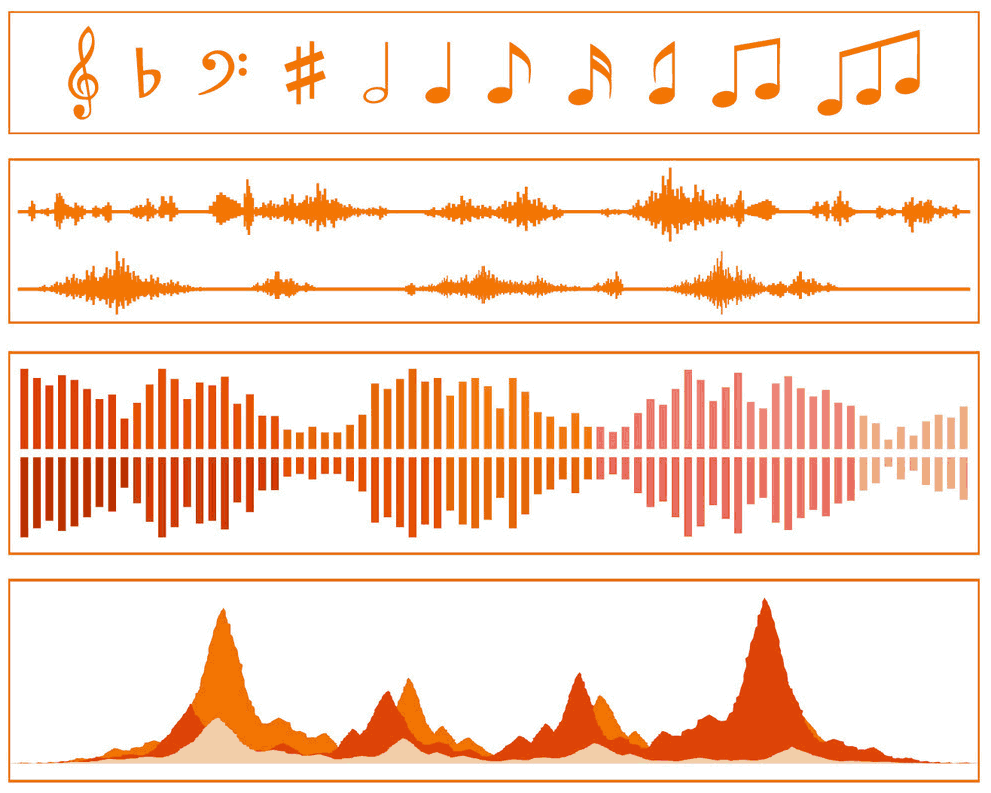
While other companies struggled to observe the magical residuum between compression and quality, Roland took another arroyo.
That's how modeling came into play. Instead of capturing sound snapshots of different playing intensities for each key, Roland added a hybrid synthesized element into the mix.
While the end results were anything but realistic, the mindset would somewhen attain greatness after a few iterations.
Five-Piano Pure Modeling Pianoforte Engine
In 2009, Roland released a digital pianoforte dubbed the Five-Piano, which was the start physically-modeled digital piano always released.
Depending on whom you ask, this was either a revolution or a 'why carp' moment. Regardless of your opinion on modeled pianos, I think it'southward difficult to deny how skillful these sound, specially considering the engine's historic period.
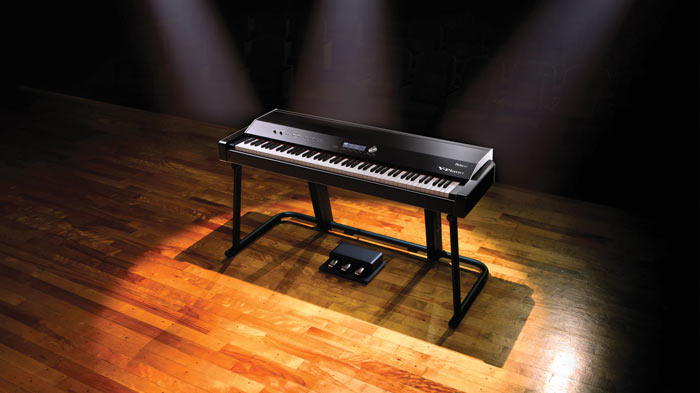
Roland V-Piano
Nosotros won't go into too much detail regarding the 5-Pianoforte engine in this article, since it'due south merely available on the RD-2000 stage piano.
No samples are used at all in the generation of the piano sound. Everything is synthesized instead. This does have a special perk though – an unlimited polyphony count.
Sadly, the negative perception meant that the 5-Piano engine was never adopted wholesale.
Thankfully, the underappreciated innovations of the V-Pianoforte model were incorporated into the side by side entry in this list.
SuperNATURAL Audio Engine
SuperNATURAL fabricated its first appearance in 2008, appearing in the Fantom-K workstations of the fourth dimension.
A more prominent appearance was in 2011's Jupiter-eighty, a performance multi-instrument that focused on synth sounds.

SuperNATURAL takes a hybrid arroyo to audio generation, using a partially-synthesized audio layered with samples to capture both the flexibility of artificial tones with the natural experience of recorded sounds.
The benefits were twofold. On one hand, you go the nuanced item you'd expect from typical studio-sampled keyboards (that many fence can't be recreated using pure modeling).
On the other mitt, people who complain virtually unrealistic modeling get placated!
In all seriousness, the SuperNATURAL audio engine is great. The fact that samples are incorporated means it isn't limited to merely piano sounds. Information technology covers everything from electric pianos, to synthesizers, to drums!
The true magic comes from the modeling side of things.
Five-Piano gave you a ton of variables to tweak to your liking. Desire to shut the lid iii/4s of the mode downward? Want to reduce the string tension while retaining the pitch? Practically everything was possible.
SuperNATURAL gives you a nearly identical amount of customization when information technology comes to the pianos and electric pianos via the Piano Designer.

It also gives you options tailored to other sounds, such every bit the filter frequency on synthesizers, glide on flute sounds, and so on.
The most notable aspect of SuperNATURAL modeling is how it'due south implemented. Instead of trying to model every single aspect of the instrument, SuperNATURAL focuses on your playing.
For instance, while playing a brass ensemble function, SuperNATURAL tracks your playing dynamics via keyboard sensors. It switches between velocity layers, EQ curves, and sample types (staccato or legato etc.) on the fly.
If yous're intimidated past all the technical jargon, yous don't need to worry. All this tracking and modulation happens backside the scenes and merely helps to bridge the gap betwixt the static nature of samples and the natural dynamics of an acoustic instrument.
Roland advertises SuperNATURAL as being 'transparent,' and that's an apt description.
There'south a lot of technology that goes into both the software and hardware, resulting in a sound engine that feels natural to play.
That'south basically what the SuperNATURAL sound engine entails. Depending on the keyboard or digital pianoforte you're getting, at that place might be differences in terms of how much you're getting.
One matter is for certain – Roland's SuperNATURAL engine is practiced and is yet in utilize today (afterward several iterations), 11 years after its release.
While we will focus on the SuperNATURAL pianoforte variants, it's worth noting that SuperNATURAL comes in a few other varieties, such as SuperNATURAL Due east. Piano, SuperNATURAL Synth, SuperNATURAL Drums, and so on.
These are sometimes included in higher-stop workstations and synthesizers, like the RD-2000 and the FA-08, and you tin can place them via the many editable parameters.
SuperNATURAL Pianoforte Sound (Entry-Level Variant)
A variant of the SuperNATURAL sound engine discussed above is featured on Roland's entry-level digital pianos, such as the FP-30X, RP-102, F701, RP701, etc.
This also uses the hybrid approach, though it definitely isn't as detailed in terms of tracking.
This version of the SuperNATURAL engine is more basic and relies more on the classic multi-sample playback system to reproduce piano sounds.

The main downgrade from the higher-cease SuperNATURAL implementations are the reliance on PCM-sample playback for non-piano sounds, resulting in a less natural audio.
Nevertheless, you're ownership an entry-level digital pianoforte for practice, and so it's not that big of a deal.
It should also be noted that more recent versions of the SuperNATURAL Piano Audio are upgraded from the older models.
The model in the RD-2000 is much improved over the first models on the early HP3xx series (HP-302, HP-305, HP-307).
SuperNATURAL Piano Modeling (High-End Variant)
Roland gave piano modeling its second wind with SuperNATURAL Piano Modeling, a variation of the sound engine dedicated to piano tones that cuts out the sample aspect entirely..
It's worth remembering that SuperNATURAL wasn't defended to pianos when it was introduced. It was fabricated for synth sounds.
This version of SuperNATURAL takes V-Piano inspiration a step farther and attempts to recreate piano sounds with digital betoken processing (DSP) applied science.
This variation on the SuperNATURAL formula makes an advent on Roland's higher-end instruments, like their HP-serial, Sixty- and GP-serial.
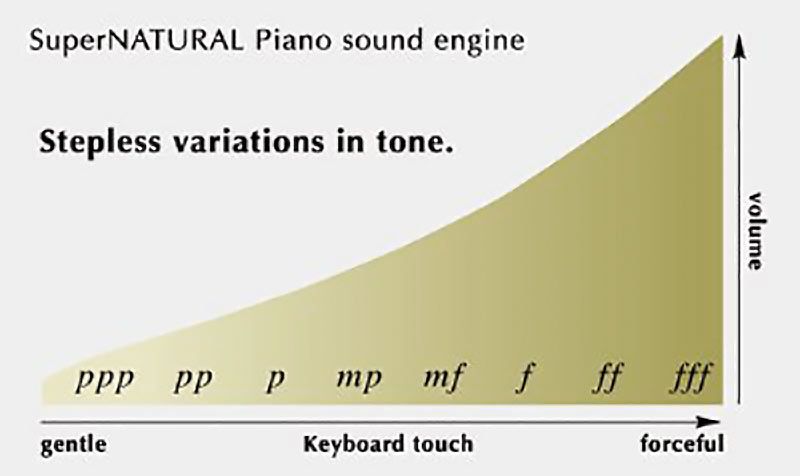
Roland doesn't advertise the modeling variant of SuperNATURAL too much, but equally a rule of thumb, if you run into the words SuperNATURAL Piano Modeling, it'due south probably entirely synthesized.
In terms of sound authenticity, these are a clear step up from the lower-end hybrid SuperNATURAL engine, providing more detail and organic elements in the sound.
That said, SuperNATURAL Piano Modeling is neither better nor worse than the SuperNATURAL Piano Sound. Information technology's merely different. Ane uses modeling while the other is based upon samples.
I've talked to people who really preferred the sample-based engine, claiming that SuperNATURAL Piano Modeling sounds constructed and unnatural. So, it'due south a thing of gustatory modality actually.
At the same time, there's no denying that the fully-modeled engine gives you more options for tweaking the audio also as greater expressiveness, which is hard to achieve using only samples.
While modeling technology hasn't enjoyed the all-time reputation, this paved the way for the latest pure modeling technology constitute in one of Roland'due south latest pianos.
PureAcoustic Piano Modeling
Featured exclusively on Roland's LX 700 series, PureAcoustic Pianoforte Modeling is Roland's latest attempt at pure modeling without whatsoever samples.
This comes nearly 10 years after the V-Piano model, released in 2009, and incorporates advancements made in technology throughout the years.

What makes PureAcoustic Piano Modeling so special? Dissimilar V-Piano and SuperNATURAL, PureAcoustic uses 2 processors, one for an American piano and the other for a European one.
1 can hear the Steinway influence from sound demos and it'south a surprisingly good emulation of the real thing.
While I've e'er liked the Five-Piano for what it does well, I can't deny how skillful PureAcoustic Piano Modeling sounds.
If I had a single complaint most V-Piano, it would exist the note decay. Real pianos have a resonant decay that is difficult to replicate without samples (and some piano modeling engines supplement their synthesized sounds with sampled decays just to sidestep the result).
Imagine my surprise that the LX-708 nails this perfectly!
The LX700-series also simulates the room aspect of samples. Since existent sounds are recorded in a real space, in that location will exist a flake of natural reverb embedded into the sample.

8-speaker setup on the LX708
With V-Piano, the reverb was mainly done through typical reverb algorithms, so nothing too special.
Here the embedded reverb is also sampled, which is mind-extraordinary when you consider the complexities that come up with simulating reverb on a per-key basis.
The cute sounds as well have inspiration from SuperNATURAL, tracking your keypresses with many sensors to ensure that the digital strings react as a existent pianoforte would.
The stop results are very realistic, and I can't look for these models to get into the more than affordable digital pianos from Roland.
Piano Designer
Roland is definitely 1 of the kings when it comes to piano modeling, but what sets them autonomously is their willingness to give you the controls to alter things equally you please.
In this department, we'll focus on the SuperNATURAL Pianoforte Designer, as it is the most prolific.

In general, Pianoforte Designer allows you lot to alter these following parameters of your pianoforte:
- Lid
- Key-Off Noise
- Hammer Dissonance
- Duplex Scale
- Full Scale String Resonance
- Damper Resonance
- Key Off Resonance
- Cabinet Resonance
- Soundboard Type
- Damper Noise
- Single Note Tuning
- Single Notation Volume
- Single Annotation Character
However, you won't find these exact options on all Roland's instruments. Depending on the model, yous can get fewer or more tweakable parameters (unremarkably more than expensive digital pianos will give you more options).
Too, you lot can find similar software solutions from other digital piano manufacturers as well. Yamaha has Piano Room and Kawai has Virtual Technician, Casio has Audio-visual Simulator.
Personally, I don't detect myself diving deep into the Piano Designer often. Unless I'yard playing a nighttime rock song, I rarely change annihilation at all (and even then, I'm just lowering the Lid parameter to get a 'far-dorsum' sound).
However, if y'all're interested in fine-tuning your audio to perfection, the Piano Designer is amazingly detailed and is generally not too hard to use.
Roland Keyboard Actions
Apart from the audio engines, a digital piano is only every bit good as the included key action. It doesn't matter how proficient a piano sounds if the keys experience bad. Normally, the best key actions feel like to those plant on actual pianos.
It might be of import to note that Roland doesn't focus heavily on delivering a realistic piano playing experience. Instead, the focus is on playability.
Afterward all, digital pianos come with more than than just audio-visual piano tones, and the hefty keys constitute on actual pianos would exist quite difficult to employ for organ and synth playing.
Synth Activity/Semi-Weighted
These keys are featured on Roland's instruments that don't focus on realistic feel, like the Due east- and BK-series.
This key action doesn't even have a specific name, but it's similar plenty that nosotros tin can embrace them all in a single category.

Synth Action
Synth-action keys completely forgo weight and experience springy and fast. Synthesizer players favor these keys, specially for lead parts.
Semi-weighted keys are likewise considered synth-action, but in that location's a flake of resistance on the activeness that tries to emulate the feel of a real piano (though not very well).
These keys are favored past organ players and electrical piano players alike due to added expressivity.
Ivory Feel-K
A somewhat outdated, fully-weighted key activity, now succeeded by the PHA-4 Standard activeness, these keys are however featured on the 88-key JUNO-DS variants, but it's nothing besides special.
These keys experience good enough on the workstation keyboard, featuring accurate velocity detection and return speed. Even so, they lack the graded effect and mod triple sensors.

PHA-4 Standard
This is the key action featured on Roland's entry-level and intermediate-level digital pianos, such as the instruments in the FP-series (aside from the FP-90X), RP-serial, etc.
The PHA in the name stands for Progressive Hammer Action, which attempts to emulate the graded feel of real pianos.
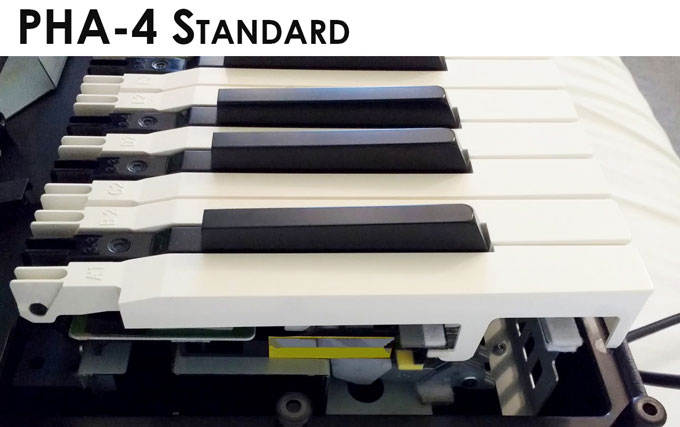
On an actual piano, the lower notes are heavier and harder to press, whereas the upper keys are lighter. The PHA cardinal actions simulate this feel by using variable weights and tends to do a skillful chore in general.
Despite existence on the lower-end of Roland's primal action selection, the PHA-iv Standard action feels surprisingly skilful and is arguably the best entry-level hammer action on the market.
The keytops feature synthetic ivory and a matte cease to prevent slippage, and triple sensors ensure that keypresses are detected accurately, even on rapid repetitions.
PHA-l
The PHA-50 action has succeeded the previous PHA-4 Premium and PHA-4 Concert key actions used in high-end Roland instruments.
This is a significant upgrade over the PHA-iv Standard action and incorporates a hybrid material construction featuring real wood to make information technology experience fifty-fifty more realistic.

PHA-l Hybrid Wood/Plastic Keyboard
The PHA-fifty activity likewise uses triple sensors and they are tuned to be even more reactive to velocity, making the overall playing experience a lot more than enjoyable.
Many keyboardists love the PHA-50 action and I'm also a fan. While information technology leans towards beingness lighter than I prefer, it however feels smashing and versatile, roofing just about any kind of sound y'all can imagine.
Hybrid Grand Keyboard
This is a variation on the previously discussed PHA-50, featured exclusively on the LX700 series digital pianos.
The main differences are longer keys and, as a outcome, longer key pivot lengths. This reduces fatigue and makes playing the keys a lot more enjoyable across extended periods of time.

The Hybrid Grand activity also incorporates a stabilizing pin, making vertical key motility smoother and quieter.
In terms of bodily experience, I'd say the Hybrid K action feels close to the real deal, having the heft and depth you'd look from a real thou piano (which is what the LX700 series is trying to recreate).
Determination
Roland's huge production line means in that location's something for everyone.
I've worked with session keyboardists who love their FA workstations to death, and I've also seen many musicians in grooming who dear the FP-series for its price to value ratio.
That'due south non even mentioning how many drummers utilise Roland'south V-Drums modules and how a ton of guitarists (myself included) use Roland'southward Dominate pedals all the time.
Roland really knows how to make instruments that audio and experience good to use, and in that location's no doubtfulness they've got a lot more than in the works.
The contempo Fantom (2019) release shows that Roland isn't sitting on their laurels. They are actively looking to aggrandize their product line with even more peachy instruments.
If y'all've ever owned or used Roland digital pianos or keyboards in the past, feel free to share your experiences in the comments below.
We'd love to hear about your likes and dislikes of Roland's products, every bit in that location's only so much my own opinions can contribute. Discussions benefit anybody, then we look forward to hearing from you!
You might besides like:
The Worst | Best Digital Pianoforte & Keyboard Brands Guide
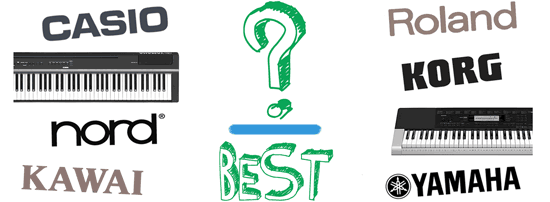
The Ultimate Guide to Ownership a Digital Piano
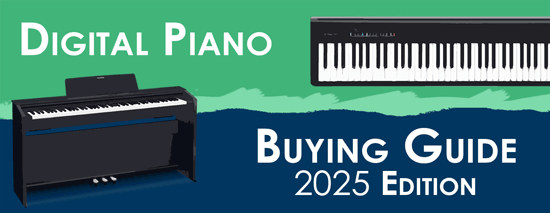
Best Digital Pianos & Keyboards (All Price Points)

Digital Piano vs Keyboard vs Synthesizer (Full Comparison)
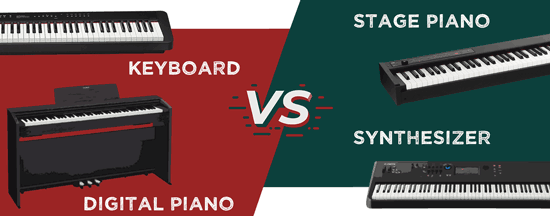
Source: https://www.pianodreamers.com/roland-digital-pianos/
0 Response to "Roland Hp 1500 Digital Keyboard Electric Piano Review"
Post a Comment